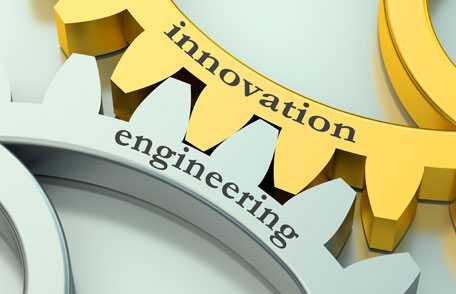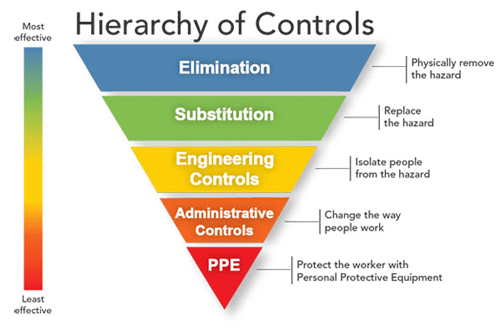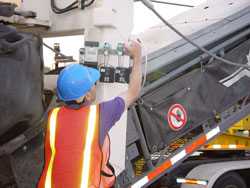Celebrate Engineers
 Engineers Solve Workplace Safety and Health Problems
Engineers Solve Workplace Safety and Health Problems
National Engineers Week is observed in February and usually surrounds George Washington’s birthday, February 22. It is recognized across the country by engineering, educational and cultural societies, universities, corporations and other government agencies. National Engineers Week calls attention to the contributions of our Nation’s highly skilled engineers. It is also a time to highlight the importance of learning Science, Technology, Engineering, and Math (STEM) skills and cultivate a love for that learning in our children.
CDC’s National Institute for Occupational Safety and Health (NIOSH) employs nearly 250 engineers and engineering technicians who identify, evaluate, develop, and implement engineering control technology to prevent occupational disease and injury. NIOSH engineers solve problems with innovative ideas for many industrial sectors including manufacturing, construction, mining, and healthcare. Many of these solutions are adopted by industry, saving the lives and improving the health of American workers.

Hierarchy of Controls Infographic
View large image and text description.
Celebrate Engineers Week 2017 (February 19–25)
Learn What NIOSH Engineers Do, Jerry Kratzer, NIOSH Engineering Technician
What are Engineering Controls?
Engineering controls protect workers by removing hazardous conditions or by placing a barrier between the worker and the hazard. Examples of engineering controls include local exhaust ventilation to capture and remove airborne emissions at the source or machine guards to shield a worker from serious physical harm such as crushed fingers or hands, amputations, burns, blindness or hearing loss. Well-designed engineering controls are highly effective and typically do not interfere with job productivity or personal comfort. Frequently, engineering controls make the work more productive and easier to perform rather than more difficult. To learn more about how engineering controls fit into the strategy for reducing and/or eliminating occupational hazards, visit NIOSH’s hierarchy of controls website.
How Do Engineers Solve Workplace Safety and Health Problems?
NIOSH researchers represent a variety of engineering disciplines (mechanical, electrical, industrial, chemical, mining, safety, and acoustical) are in a unique position to protect workers. They conduct prevention-oriented research in the field of occupational safety and health (OSH) and collaborate with other OSH experts such as industrial hygienists and physicists on a national and sometimes international scale to develop these successful solutions. NIOSH leads a national initiative called Prevention through Design (PtD) to prevent or reduce occupational injuries, illnesses, and fatalities through the inclusion of prevention considerations in all design aspects that impact workers.
NIOSH engineers plan and conduct research on engineering control technology to prevent worker exposure to hazards and promote the application of effective engineering control technologies through dissemination efforts. They also provide recommendations directly to companies who need assistance in applying engineering control solutions for a particular workplace health and safety problem.
NIOSH engineering research activities include:
- Laboratory research to test ideas that need further refining or would be difficult to evaluate in the field. NIOSH has access to state-of-the-art ventilation laboratories and instrumentation to conduct research.
- Walk-through or preliminary surveys are conducted to become familiar with a particular facility or industry. These surveys are normally of short duration and will include very limited exposure monitoring and engineering control performance data.
- In-depth surveys of longer duration include extensive data collection on worker exposure assessments and engineering control performance. These are normally the basis for detailed recommendations for protecting workers from specific hazards in a given industry.
- Computational fluid dynamics (CFD) modeling for the design and evaluation of controls and investigation of hazards associated with emerging technologies and changing workplace environments.

NIOSH Engineer Sampling Respirable Crystalline Silica Dust near Asphalt Milling Machine during an In-Depth Survey (Photo by NIOSH)
NIOSH engineers are sought after for their expertise by many other government agencies and outside entities. This is evidenced by the number of interagency agreements and CDC Foundation awards with NIOSH research programs. NIOSH has partnered with the US Coast Guard, U.S. Navy, U.S. Postal Service, FAA, Department of Justice, OSHA, Department of Homeland Security, and others.
What Have Our Engineers Accomplished?
- Published peer-reviewed articles on the prevention of Tuberculosis (TB) transmission in healthcare settings and prisons, isolation room design and expedient isolation, use of ultraviolet germicidal irradiation and preventing disease transmission on commercial aircraft, and ambulances.
- Reduced asphalt fume and silica exposures for highway construction workers using paving and milling equipment.
- Evaluated carbon monoxide (CO) emissions controls for small engines (like generators) providing a safer boating environment and reducing the risk of CO poisonings for construction workers who use engine-powered tools.
- Developed mobile apps to support proper ladder use and reduce occupational noise-induced hearing loss, and a web-based simulator to familiarize aerial lift operators with jobsite hazards.
- Developed and patented a roof bracket and safety rail system that provides fall protection around roof and floor openings to keep workers safe in residential, industrial, and commercial construction settings.
- Published several crash test methods to improve the design and safety of the ambulance patient compartment.
- Prepared several occupation-specific databases for use in improving vehicle design, engineering controls, and personal protective equipment.
- Other research includes the study of hazardous exposures in postal facilities, engineering controls for nanomaterials, computational fluid dynamics applications, reducing exposures to flavoring chemicals, and reducing exposures to emergency response workers.
Did you know?
George Washington was a surveyor at age 17? Modern day surveyors are knowledgeable in engineering, geography, math, statistics, physics, programming languages and the law.
What Projects Are NIOSH Engineers Working On Now?
NIOSH engineers are currently developing engineering controls for 3D printing. The goal of the project is to reduce occupational exposures to nanoparticles and other emissions from these increasingly widely used devices. Both laboratory and field studies are being conducted to understand what emissions are released from industrial-sized 3D printers. Engineers will then work to improve current controls and develop new controls where needed to eliminate or reduce exposures to acceptable levels.
Another study focuses engineering expertise in the field of CFD to quantify the risk of exposure to infectious diseases in aircraft cabins. Because of recent outbreaks of Middle East Respiratory Syndrome (MERS) and Ebola Virus Disease added to past concerns with Severe Acute Respiratory Syndrome (SARS) and PAN Flu, there is interest in understanding how infections spread during air travel. The Generalized Aircraft Air-contaminant Transport Effect (GAATE) model uses experimental data to create a predictive statistical model that estimates exposure based on distance from a source like an ill passenger. By inputting the seat location of the infection source, the model shows how far the infectious particles are likely to spread. This type of information could be very useful during an outbreak of a new or common disease and the design of cabin ventilation systems or isolation techniques to minimize exposures to other passengers on the aircraft.
Because occupational safety and health challenges are changing due to new processes, novel materials, and emerging industries, there will always be a need for engineers to work on new controls to protect workers. Engineers are a vital part of the NIOSH research community who keep American workers safe.
More Information
More Information
- Discover Engineers Week
- NIOSH Engineering Controls
- NIOSH Engineering Control Database (NECD)
- NIOSH Engineering and Physical Hazards Reports
- Prevention through Design (PtD)
- NIOSH Engineering Controls Program, Innovative Technologies for Safeguarding Worker Health
- NIOSH Ladder Safety App
- NIOSH Sound Level Meter App
- NIOSH Aerial Lift Hazard Recognition Simulator
- Anthropometry
- Engineering and Public Health at CDC
- National Society of Professional Engineers
- American Society of Civil Engineers
- Page last reviewed: February 17, 2017
- Page last updated: February 17, 2017
- Content source:
- National Institute for Occupational Safety and Health
- Page maintained by: Office of the Associate Director for Communication, Digital Media Branch, Division of Public Affairs




 ShareCompartir
ShareCompartir